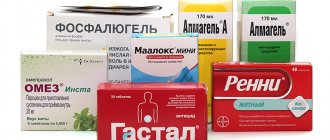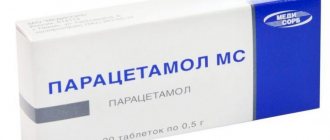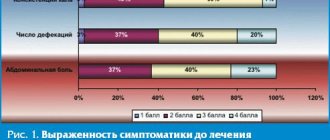Instructions
When attacks of heartburn and stomach pain occur, the question arises of what is better to purchase: Almagel or Phosphalugel. Both medications are similar in their action and are used for inflammatory diseases.
When attacks of heartburn and stomach pain occur, the question arises of what is better to purchase: Almagel or Phosphalugel.
Indications for use
Medicines are prescribed for heartburn, sour belching and pain caused by hypersecretion of gastric juice. Inflammation of the pancreas is also an indication. Medicines help with a wide variety of stomach diseases:
- gastritis;
- ulcer;
- reflux esophagitis.
The drugs are used in the complex treatment of gastrointestinal disorders such as pancreatitis, colitis and poisoning. Medicines neutralize the aggressive effects of gastric juice on the mucous membrane, enveloping it and stimulating regeneration processes.
Side effects
Long-term treatment with Almagel can provoke high concentrations of magnesium, calcium and phosphates in the blood. This can disrupt the functioning of major organs and systems.
The main load goes to the digestive tract:
- - stomach ache;
- – diarrhea;
- - nausea, vomiting;
- - violation of taste.
Rare adverse reactions:
- – dementia;
- – swelling of the arms and legs.
Treatment of gastritis with the drug "Phosphalugel" can cause constipation. This adverse reaction most often occurs in elderly people and bedridden patients.
How are the drugs different?
The difference between the two drugs is that they have different active ingredients. At the same time, Almagel has a wider scope of application than Phosphalugel.
The active ingredients of Almagel eliminate pain within 5 minutes after administration.
Characteristics of active ingredients
Almagel contains aluminum and magnesium oxides, which reduce the acidity of gastric juice. At the same time, a protective barrier is formed on the surface of the mucous membrane. If a person takes NSAIDs and glucocorticosteroids, then treatment with Almagel reduces the likelihood of inflammation and ulcer formation.
The active components of the drug are also capable of absorbing harmful substances. The active ingredients eliminate pain within 5 minutes after administration. The therapeutic effect lasts for 1-2 hours.
The active component of Phosphalugel is aluminum phosphate.
This component is not absorbed into the gastrointestinal tract, but acts only on the surface of the mucous membrane, protecting it from damage by hydrochloric acid. Aluminum phosphate affects the concentration of gastric juice and the activity of pepsin.
Which is better: Almagel or Phosphalugel?
Both drugs are effective, but thanks to the additional component in the composition, Almagel can be considered more effective.
Contraindications and negative effects
You should avoid taking the drug in case of increased susceptibility to the constituent components of the drug, as well as in persons who have kidney pathologies. The medicine has no other contraindications.
Negative manifestations after administration appear in rare cases. Elderly people and bedridden people may experience constipation.
Since the composition contains many aluminum ions, intestinal motility may deteriorate. In case of overdose, you need to take a laxative.
Directions for use and dosage
Almagel suspension is recommended to be taken 60 minutes after meals, as well as before bedtime, to prevent a burning sensation in the stomach. You can take the medicine directly when pain occurs in the gastrointestinal tract. Single dose - 1 measuring spoon. Phosphalugel is recommended to be taken according to the same regimen as Almagel. The course of treatment depends on the severity of the symptoms and can vary from 1 week to a month. These medications should be taken 3 times a day or whenever pain occurs.
To eliminate stomach pain, phosphalugel is taken 1 scoop 3 times a day.
Modern antacid drugs in gastroenterological practice
The possibility of a rapid therapeutic effect, primarily in the elimination (reduction of intensity) of heartburn and pain, after taking antacid drugs per os has long attracted the attention of doctors and researchers. This quality of antacid drugs distinguishes them favorably from drugs of other classes, including H2-blockers of histamine receptors and proton pump inhibitors, the use of which in the treatment of patients can significantly reduce acid formation in the stomach, but their effect occurs somewhat later, and the financial cost is much higher.
The main point of application of antacid drugs is the neutralization of hydrochloric acid secreted by the parietal cells of the gastric mucosa. According to the observations of some researchers [14], when taking antacid drugs in usual therapeutic dosages, the acidity level is no more than 5 (the drugs neutralize only excess acidity of gastric juice), however, when the acidity level decreases to 1.3–2.3, these drugs neutralize 90% gastric juice, and at a value of 3.3 - 99% gastric juice.
Antacid drugs have been used for a long time in the treatment of patients suffering from various gastroenterological diseases, primarily acid-related diseases. Currently, a large group of diseases of the upper gastrointestinal tract are classified as acid-dependent, regardless of whether the factor of acid aggression is central or only additional, leading to the occurrence and progression of these disorders. Among acid-related diseases, the most common are gastric and duodenal ulcers, gastroesophageal reflux disease (GERD), non-ulcer (functional, essential) dyspepsia (NFD), pancreatitis, ulcers associated with non-steroidal anti-inflammatory drugs (NSAIDs), Zollinger-Ellison syndrome [1 ]. Some researchers also include ulcers, which can occur with hyperthyroidism, as acid-dependent diseases [13]. In our opinion, these disorders can also include an idiopathic hypersecretory state, peptic ulcers of gastroenteroanastomosis, which occur in some patients after gastrectomy, and, to some extent, Cushing's ulcers, as well as ulcers that appear with celiac enteropathy.
When treating patients suffering from acid-dependent diseases, various antacid drugs are used, which differ from each other to a greater or lesser extent, primarily in composition, speed of onset of the therapeutic effect, duration and effectiveness of the effect. These qualities of drugs depend to some extent on their form (tablet, gel, suspension). However, most modern antacid drugs have something in common - a decrease in the concentration of hydrogen ions in the stomach, resulting from the neutralization of hydrochloric acid; in addition, the neutralizing effect causes a decrease in peptic activity. In addition, in the stomach, antacid drugs bind bile acids and lezolecithin, providing an enveloping effect. Some of the antacid drugs (in particular, those containing aluminum hydroxide) also have a cytoprotective effect, which consists in enhancing the secretion of mucus and the synthesis of prostaglandins. It also turned out that antacid drugs are able to bind epithelial growth factor and fix it in the area of the ulcer, stimulating cell proliferation, angiogenesis and tissue regeneration [1].
Taking into account the antagonistic effect of magnesium intravenously injected into the stomach on acid hypersecretion caused by calcium carbonate, products containing a mixture of calcium carbonate and magnesium oxide hydrate were created. However, such antacid drugs do not eliminate the stimulating effect of calcium carbonate on acid secretion in the stomach. In addition, antacid preparations containing calcium carbonate, when interacting with hydrochloric acid in the stomach, cause the formation of a significant amount of carbon dioxide, which leads to the appearance or intensification of flatulence, and in the presence of cardia insufficiency, including those combined with a hiatal hernia, - burps.
The stimulatory effect of some antacid drugs on gastric acid secretion is partly associated with alkalization of the gastric antrum, the release of gastrin and possibly other neurohormonal factors, and partly with the direct effect of these antacid drugs on the parietal cells of the gastric mucosa.
Repeated attempts have been made to somehow classify antacid drugs (absorbable and non-absorbable, local and systemic, anionic and cationic, combined and monocomponent). The most common types are absorbable and non-absorbable antacid drugs. The absorbable group usually includes drugs such as sodium bicarbonate (soda), basic magnesium calcium carbonate - a mixture of Mg(OH)2, 4MgCO3, H2O, magnesium oxide (burnt magnesia), basic calcium carbonate - CaCO3, a mixture of Bourget (Na sulfate, Na phosphate and Na bicarbonate), Rennie's mixture (calcium carbonate and magnesium carbonate), Tams mixture (calcium carbonate and magnesium carbonate). These antacid drugs are characterized by the relative speed of onset of the therapeutic effect (the disadvantage is the short duration of neutralization of hydrochloric acid). Typically, these drugs, having a systemic effect, increase the alkaline reserves of the plasma, changing the acid-base balance, and neutralize (with local action) hydrochloric acid in the stomach, which in some cases can lead to “acid rebound” syndrome due to the persistent appearance of hypersecretion of acid in the stomach after taking such antacid drugs [12]. In particular, these antacid drugs include calcium carbonate, which, soon after administration, begins to stimulate the secretion of acid in the stomach - accelerated neutralization of hydrochloric acid in the stomach, activates an increase in its secretion by the parietal cells of the gastric mucosa. In this regard, calcium carbonate is now very rarely used in the treatment of patients.
The group of non-absorbable antacid drugs most often includes drugs such as phosphalugel (aluminum salt of phosphoric acid), the so-called aluminum-magnesium antacid drugs (Maalox, Almagel Neo, Taltsid, Protab, Magalfil, etc.) and aluminum-magnesium antacid drugs with the addition of alginate (topalcan). A common feature of the primary action of this group of drugs (upon entry into the stomach) is the adsorbing effect on hydrochloric acid with its subsequent neutralization. Unlike absorbable antacid drugs, non-absorbable antacid drugs have a longer-lasting antisecretory (neutralizing) effect (up to 2-3 hours), do not cause changes in acid-base balance and do not lead to an increase in the pH of the gastric contents above the neutral value, without causing “acid acid” syndrome. ricochet."
Modern antacid drugs differ among themselves and in the composition of cations (magnesium, calcium, aluminum), which largely determines their basic properties (neutralizing, adsorbent, enveloping, astringent and cytoprotective effects).
Unlike monocomponent antacids, combined antacid preparations consist of several components that make them up and have different properties, depending on the composition. Sometimes aluminum-containing preparations are isolated (phosphalugel, maalox, almagel, gelusil varnish, talcid, etc.), one of the significant advantages of which, along with the neutralization of hydrochloric acid in the lumen of the stomach, is the protection of the mucous membrane of the esophagus and stomach from the effects of the acid-peptic factor. Combined antacid drugs, especially those containing aluminum, have different mechanisms of action, including a combination that neutralizes hydrochloric acid and increases the protective properties of the mucous membrane, i.e., apparently, they also have a cytoprotective effect.
When assessing the effectiveness of antacid drugs, their acid-neutralizing ability and duration of action are most often taken into account. This fact is very important: the duration of antacid exposure is one of the main factors in assessing the therapeutic effectiveness of antacid drugs used in the treatment of patients. It is known that antacid drugs, due to their ability to be adsorbed on the gastric mucosa, cause a persistent acid-neutralizing effect, allowing them to exhibit buffering properties at a level of 2.4 pH.
The acid neutralizing activity of different antacid drugs ranges from less than 20 mmol/15 ml of antacid drug to 100 mmol/15 ml [8]. The acid-neutralizing ability (activity) of antacid drugs is usually understood as the amount of a specific antacid drug in grams or mmol/l required to achieve a pH level of 50 ml of 0.1 N hydrochloric acid solution to 3.5 [4].
Among antacid drugs, those associated with the calcium carbonate group have the shortest duration of action, those associated with the magnesium group have a somewhat longer duration of action, and those associated with the phosphorus group have an even longer duration (up to 90 minutes). There are also other data on the duration of action of antacid drugs [11], in particular, those containing aluminum phosphate, which have an antacid effect due to their absorption on the gastric mucosa, which extends the duration of their buffering capacity at a pH value of 2.4 to 120 minutes.
According to a number of researchers [11], combinations of aluminum and magnesium hydroxides, as well as calcium and magnesium carbonates, mainly exhibit only neutralizing activity, which also includes accelerated passage of food through the stomach. A study of the properties of some antacid drugs [2], according to intragastric computer pH-metry, using a 3-electrode pH probe, showed that the shortest time from the start of administration of the antacid drug to the increase in pH (on average 8.9 minutes) was found in Maalox, the longest time is for Almagel (on average 13.5 minutes) compared to Remagel, Phosphalugel, Megalac; The average duration of the alkalizing effect (alkaline time - from the beginning of the pH increase to the return to the initial level) for antacid drugs ranged from 28 minutes for Almagel to 56 minutes for Maalox. At the same time, Remagel, Phosphalugel and Megalac occupied an intermediate position between Almagel and Maalox. Analysis of pH grams showed that the maximum pH values after taking various antacid drugs differed slightly.
Therapy with antacids
Antacid drugs can be successfully used in the drug therapy of all acid-dependent diseases in the following cases: 1) as monotherapy in the initial stages of these diseases; 2) as additional agents (for example, when treating patients with histamine H2 receptor blockers or prokinetics); 3) as a symptomatic means to eliminate (reduce intensity) heartburn and pain in the chest and/or epigastric region, both during the treatment of patients, combining their use with other drugs, and during the period of remission (including as therapy “ on demand"); 4) during the screening phase before the start of the intended treatment, when selecting patients for randomized studies to study the effectiveness and safety of certain medications or regimens for their use (as a rule, taking antacid drugs is allowed according to the protocols of these studies), as well as directly during timing of such studies as emergency treatment in cases where the efficacy and safety of prokinetics, H2-blockers of histamine receptors, proton pump inhibitors or so-called cytoprotective drugs are being studied.
In such cases, the undoubted advantage of antacid drugs is taken into account - the rapid elimination (reduction of intensity) of heartburn (burning) behind the sternum and / or in the epigastric region and other gastrointestinal symptoms caused by the disease itself, for which patients are being treated, taking medications and intoxication .
One of the antacid drugs that periodically attracts the attention of researchers and doctors is phosphalugel (colloidal aluminum phosphate in the form of an oral gel containing 8.8 g in one sachet). Phosphalugel is often classified as a non-absorbable antacid drug. Most of the aluminum phosphate gel is insoluble, but at a pH less than 2.5, the phosphalugel turns into water-soluble ammonium chloride, some of which is able to dissolve, after which further dissolution of the aluminum phosphate is suspended. A gradual decrease in the acidity level of gastric contents to pH 3.0 does not lead to the occurrence of “acid rebound”: the use of phosphalugel in the treatment of patients does not lead to the appearance of secondary hypersecretion of hydrochloric acid.
One of the advantages of phosphalugel is its acid-neutralizing ability depends on the level of acidity: the higher the acidity, the more active the effect of this drug [10]. An increase in pH under the influence of the drug leads to a decrease in the proteolytic activity of pepsin. The drug does not cause alkalization of gastric juice, does not limit enzymatic processes and does not disrupt the physiological conditions of the digestion process. Long-term use of the drug does not affect phosphorus metabolism. The actual effect of phosphalugel, which is in the form of hydrophilic colloidal micelles of the drug, is determined by colloidal aluminum phosphate, which has an antacid, enveloping and adsorbing effect. A small part of phosphalugel precipitates in the intestine in the form of oxides and insoluble carbonates, which enhances its protective, adsorbent and antacid effect. One gram of aluminum phosphate gel micelles, consisting of aluminum phosphate, agar gel and pectin, has a contact surface of about 1000 m², which ensures intensive communication with the walls of the digestive tract and adsorption of harmful substances. Gels of pectin and agar-agar, which are part of the drug, are involved in the formation of a mucoid, antipeptic protective layer in the gastrointestinal tract. Colloidal aluminum phosphate binds endogenous and exogenous toxins, bacteria, viruses, gases formed as a result of putrefaction and pathological fermentation throughout the gastrointestinal tract, normalizing their passage through the intestines and thereby facilitating their removal from the body of patients. The drug also reduces pain [3]. Adults and children over 6 years of age are usually prescribed 1-2 sachets 2-3 times a day immediately after meals and at night (for reflux esophagitis) or more often (for other diseases) - 1-2 hours after meals.
One of the antacid drugs that has recently also attracted the attention of doctors is hydrotalcite (rutacid, talcid), a drug with a low content of aluminum and magnesium. Among the features of the mechanism of action of this drug is the gradual release of aluminum and magnesium ions depending on the pH state of the gastric contents. Other advantages of hydrotalcite are rapid and long-term neutralization of hydrochloric acid with maintaining a pH close to normal levels, a protective effect on the gastric mucosa with a decrease in the proteolytic activity of pepsin, binding of bile acids, and also the form of release of the drug - in the form of chewable tablets that should be chewed thoroughly . When treating adult patients, hydrotalcite is usually prescribed 500–1000 mg (1-2 tablets) 3-4 times a day, 1 hour after meals and before bedtime; after errors in the diet, accompanied by the appearance of symptoms of discomfort, as well as in case of alcohol abuse - 1-2 tablets once. For children aged 6–12 years, the dosage is reduced by 2 times. The duration of treatment is determined by the general condition of the patients. It is not recommended to take this drug at the same time as drinking acidic drinks (juices, wine).
It is known that, along with dyspeptic disorders, usually associated with various diseases of the esophagus and stomach, a significant proportion of patients are bothered by flatulence, which occurs for various reasons, including in patients, according to our observations, who have been taking proton pump inhibitors for a long time. The appearance on the Russian domestic market of a new antacid water-soluble drug Almagel Neo, containing in its composition the optimal amount of aluminum hydroxide and magnesium hydroxide (compared to the previously widely known Almagel suspension, the content of the latter is increased by 3.9 times) and simethicone (defoamer) introduced into its composition , allows patients with preserved and increased gastric secretion to obtain a positive effect in eliminating symptoms of discomfort, including flatulence, in a short time (on average on the fifth to seventh day); Only in cases of severe symptoms of flatulence, treatment of patients with Almagel Neo should begin with the use of 60 ml/day [13]. The effectiveness of this drug is due to its high acid-neutralizing ability, the presence in its composition of simethicone (a surfactant that reduces the external tension of gas bubbles), which promotes the natural release of intestinal gases and their absorption, which to a certain extent prevents the occurrence of stool retention (constipation) and flatulence , reduces the likelihood of belching. The presence of neo sorbitol in Almagel allows it to be used in the treatment of patients who, along with one of the acid-related diseases, also have diabetes mellitus. The usual dosages for prescribing this drug to patients are: orally for adults, 1 sachet or 2 dosage spoons 4 times a day, 1 hour after meals and at night; For children over 10 years of age, the dosage of the drug is determined by the attending physician (taking into account the body weight and condition of the child).
There are different options for prescribing antacid drugs to patients for various diseases, but most often antacid drugs are prescribed in the following cases: with the so-called “on-demand” therapy for the rapid elimination (reduction of intensity) of the symptoms of dyspepsia, especially heartburn and pain (at any time of the day) ; during a course of treatment 30–40 minutes before or 30–60 minutes after a meal (if necessary and before bedtime) as monotherapy or in complex treatment, in combination, first of all, with prokinetics and/or with H2-blockers of histamine receptors (the frequency and duration of taking antacid medications are determined by the general condition of the patients). The positive effect of antacid drugs in eliminating pain in the chest and/or epigastric region and/or heartburn (burning) in itself indicates the presence of an acid-dependent disease in the patient. Most often, as observations show, antacid drugs may be necessary in the treatment of patients suffering from peptic ulcer disease, chronic pancreatitis, GERD and/or NFD, which can be combined with chronic hyperacid or normacid gastritis, and is also possible in patients with NFD syndrome without morphological signs of gastritis.
As our observations have shown, it is most advisable to use antacid drugs in the following cases. For peptic ulcer disease associated with Helicobacter pylori (HP), after eradication therapy when pain and/or dyspeptic disorders, especially heartburn, appear in patients. However, due to the adsorbing ability of antacid drugs, their use directly during Helicobacter pylori eradication therapy is not justified: during this period, patients take quite a lot of tablets or capsules - 6 times a day the basic drug (proton pump inhibitor, ranitidine or bismuth drug) in combination with 2 antibiotics (first-line therapy) or 13 times a day 4 drugs (second-line therapy), as the likelihood of a decrease in the effectiveness of both antibiotics and the basic drug(s) increases. Taking into account the number of medications used by patients during the day and necessary to obtain the eradication effect, i.e., the destruction of Helicobacter pylori (HP), in the case of additional prescription of antacid drugs, the number of tablet forms of drugs will exceed the specified number of drug doses (taking into account dosages), more than 6 and 13 times a day in first- and second-line therapy, respectively.
For peptic ulcers not associated with HP, antacid drugs can be successfully used as independent therapy for newly diagnosed, uncomplicated duodenal ulcers (with small ulcers), as well as as additional therapy for gastric and duodenal ulcers to H2 - histamine receptor blockers, or in on-demand therapy for them or proton pump inhibitors. The success of treating patients largely depends on the depth of the ulcer.
When comparing the results of a 4-week treatment of 2 groups of patients suffering from uncomplicated duodenal ulcer (one of the groups was treated with various antacid drugs in “liquid” form or in tablet form, 4-6 times a day, which had different neutralizing abilities - from 120 to 595 mEq of H+ anions per day, another group of patients was treated in therapeutic doses with H2-blockers of histamine receptors [7]), there were no significant differences in the time of disappearance of clinical symptoms and healing of ulcers. Another study [6] compared the results of treatment of 42 patients treated with phosphalugel, 11 g of aluminum phosphate gel 3 times a day (after meals) for 4 weeks, and treatment of 49 patients treated with ranitidine, 150 mg 2 times a day, also in for 4 weeks, showed the following: healing of duodenal ulcers was noted in 60 and 55% of cases, respectively. According to another study [7], based on an analysis of the results of a 6-week treatment of 153 patients who received aluminum phosphate (1 sachet = 11 g of gel) 5 times a day, ulcer healing was established in 65% of cases.
Depending on the stage of treatment of GERD, antacid drugs can be effectively used in the following cases: as the main drug in some patients with endoscopically negative GERD and with GERD in the stage of mild reflux esophagitis (with minimally expressed symptoms); in combination with H2-blockers of histamine receptors in the course treatment of patients with GERD in the stage of mild or moderate reflux esophagitis, as well as during on-demand therapy; during a course of treatment of patients with GERD in the stage of erosive reflux esophagitis in combination with H2-blockers of histamine receptors, in on-demand therapy in combination with continuous treatment of patients with proton pump inhibitors (during exacerbation of the disease); during a course of treatment of patients with GERD in the stage of peptic ulcer of the esophagus in combination with H2-blockers of histamine receptors or in on-demand therapy (while treating patients with proton pump inhibitors).
To improve the condition of patients, it is advisable to use antacid drugs in the treatment of patients suffering from other diseases: in particular, with erosive and ulcerative lesions of the stomach and duodenum associated with non-steroidal anti-inflammatory drugs, with erosive and ulcerative lesions of the upper gastrointestinal tract, the occurrence of which possible with decompensated liver cirrhosis, with peptic ulcer disease combined with celiac enteropathy, and with Zollinger-Ellison syndrome.
During the treatment of patients with the listed diseases, it is advisable to use antacid drugs during a course of therapy in combination with H2-blockers of histamine receptors (in on-demand therapy and with proton pump inhibitors).
The use of antacid drugs is useful, as observations have shown, in the treatment of patients with acute gastritis (as an additional adsorbent agent for various types of acute gastritis); as an additional therapy (to H2-blockers of histamine receptors or to proton pump inhibitors) for Cushing's ulcers; in the treatment of patients with peptic ulcers of gastroenteroanastomosis and patients with chronic pancreatitis. Antacids are used in combination with H2-blockers or proton pump inhibitors as on-demand therapy.
It is advisable to use antacid drugs in the treatment of patients with functional bowel diseases in order to eliminate pain and/or discomfort. It was shown [9] that one dose of aluminum phosphate gel with a volume of 100 to 300 ml, prescribed per os, just before taking a dose of radiostrontium 85Sr, reduced the absorption of the latter by 87.5%, while a dosage of 100 ml of aluminum phosphate gel was just as effective , as well as 300 ml, which indicates other possibilities for using antacid drugs.
It is known that aluminum phosphate gel, which is a combination of an antacid and substances that cover and protect the mucous membrane from the pathological effects of acid and bile acids, helps eliminate (reduce) their “irritating” (pathological) effect on the mucous membrane of the esophagus and stomach, which makes it possible to recommend short-term the use of this drug in pregnant women or during lactation after childbirth [5]. The same advantages of phosphalugel (cytoprotective effect of the drug) protect the mucous membrane from damage and from the effects of alcohol [4].
As a symptomatic (additional) remedy for eliminating (reducing the intensity) symptoms of dyspepsia, antacid drugs can also be used in the treatment of patients with organic dyspepsia of various etiologies (for example, before surgical treatment of patients, if necessary, and after it), as well as to eliminate symptoms of discomfort in people who consider themselves healthy.
Features of prescribing antacids
When prescribing antacid drugs, it is necessary to take into account the mechanism(s) of their action and the symptoms of diseases observed in specific patients (constipation, diarrhea, etc.). In particular, in the presence of diarrhea (as additional means, if necessary), it is advisable to treat patients with antacid drugs containing aluminum (almagel, phosphalugel, rutacid, talcid); for constipation - antacid medications that contain magnesium (Gelusil Lac, Gastal, etc.).
It is known that antacid drugs (when entering the body of patients) have an adsorbing ability, due to which it is possible to reduce the activity and bioavailability of some medications taken by patients (for example, H2-blockers of histamine receptors, non-steroidal anti-inflammatory drugs, antibiotics, etc.). Therefore, when prescribing antacid drugs in combination with other drugs, it is advisable to recommend that patients observe the time interval between taking antacid drugs and other drugs (before or after, about 2-2.5 hours), i.e., indicate the time patients take specific drugs during the day .
According to our observations, the effect of taking antacid drugs produced in the form of gels or suspensions (compared to tablet forms) occurs faster, although the tablet form seems somewhat more convenient for storage (especially when traveling).
When deciding on the use of antacid drugs, especially long-term (in high dosages), it is necessary to take into account the possibility of side effects. Side effects that are possible in some patients while taking antacid drugs largely depend on the individual characteristics of the patient, the dosage of antacid drugs and the duration of their use. Constipation or diarrhea (depending on the particular antacid drug used in the treatment of patients) are the most common side effects that occur in patients while taking antacid drugs. A significant increase in the dosage of antacid drugs is the main cause of constipation or diarrhea, and long-term, uncontrolled use is the main cause of metabolic disorders.
In particular, one of the features of the action of magnesium-containing antacid drugs is an increase in intestinal motor function, which can lead to normalization of stool, but if taken in excess, to the development of diarrhea. An overdose of magnesium-containing antacid drugs (an increase in Mg+++ ions in the patient’s body) increases the magnesium content in the patient’s body, which can cause bradycardia and/or insufficiency of renal function.
Antacid drugs containing calcium, in case of overdose, cause an increase in Ca++ in the body of patients (the occurrence of hypercalcemia), which can lead to the so-called “alkaline” syndrome in patients suffering from urolithiasis, which, in turn, contributes to increased formation of stones. A decrease in the production of parathyroid hormone can lead to a delay in the excretion of phosphorus, an increase in the content of insoluble calcium phosphate and, consequently, to calcification of the body tissues of patients and the occurrence of nephrocalcinosis.
The level of aluminum absorption may be different for different drugs, which must be taken into account when determining the possible risk of side effects due to the fact that antacid drugs containing aluminum can cause hypophosphatemia in some patients, especially with prolonged use; in renal failure - encephalopathy, osteomalacia (with an aluminum level of more than 3.7 µmol/l), clinical symptoms considered characteristic of poisoning (with an aluminum concentration of more than 7.4 µmol/l). It is also necessary to take into account the fact that the lower toxicity of aluminum phosphate A1PO4, compared to aluminum hydroxide A1(OH)3, is due to its greater resistance to dissolution and the formation of neutral complexes in the presence of acids usually contained in food, which indicates the lower toxicity of the phosphate aluminum
As a rule, the occurrence of side effects can be avoided if, when prescribing antacid drugs, the mechanism of their action, the condition of specific patients is taken into account, and, in addition, if detailed explanatory work is carried out with patients before prescribing antacid drugs.
For questions regarding literature, please contact the editor.
Yu. V. Vasiliev, Doctor of Medical Sciences, Professor
Central Research Institute of Gastroenterology, Moscow
special instructions
Almagel is not recommended for use in case of chronic constipation, suspected appendicitis and ulcerative colitis. The drug can be harmful in case of inflammation of hemorrhoids, diarrhea of unknown origin and liver cancer. The medicine is prescribed with caution to persons with acid-base balance disorders in the body.
This drug may worsen the condition of patients with heart failure. Both medications should be taken with caution in severe renal and liver dysfunction. In some cases, aluminum hydroxide can lower blood pressure.
Pregnancy and lactation
Both drugs can be used by pregnant and breastfeeding women after consulting a doctor.
Childhood
Phosphalugel can be given to children from 6 months after feeding. Almagel is allowed only from 10 years of age.
Elderly age
Both medications should be used with caution in old age.
Characteristics of active ingredients
In fact, these drugs are not considered complete analogues, since they contain different active ingredients. Phosphalugel is aluminum phosphate in gel form. Almagel contains aluminum hydroxide and magnesium hydroxide. But the effects on the body of different aluminum salts and magnesium salts are similar.
First of all, they all have an antacid effect, that is, they neutralize hydrochloric acid, which is part of the gastric juice.
Both drugs envelop the walls of the stomach, protecting against the destructive effects of aggressive substances (aspirin, diclofenac, alcohol, food alkalis and acids, etc.)
The adsorbent properties allow these products to absorb harmful microorganisms and toxins and remove them naturally, thus cleansing the stomach and intestines.
Analogs
The choice of antacid and sorbent agents in pharmacies is quite large: Maalox, Smecta, Omeprazole, Enterosgel, Gastal. However, only Hephal, Alfogel, Gasterin (the active ingredient in them is aluminum phosphate) can be considered complete analogues of Phosphalugel.
Almagel analogues: Alugel, Almox, Maalox (contain magnesium hydroxide and aluminum hydroxide).
Only a doctor can choose the right drug from this variety in a particular case. Please contact a specialist for an appointment. Be healthy!
Which is better: Almagel or Phosphalugel?
This question, of course, is not correct. It's better what the doctor prescribes. For a small child, he will, of course, prescribe Phosphalugel (or another age-appropriate drug). But this does not mean that Phosphalugel is better. Almagel is more effective in some conditions. Almagel A, for example, contains anesthesin, which relieves pain. (Phosphalugel and Almagel also have an analgesic effect by enveloping the walls of the stomach, but this is less effective.) Almagel Neo contains simethicone, which fights gas formation.
In short, you need to evaluate all the symptoms in order to choose the most suitable drug.
Efficiency comparison
When comparing drugs, they usually rely on several indicators:
- efficiency;
- portability;
- age restrictions;
- price;
- contraindications and side effects.
When choosing Phosphalugel or Maalox - which is better , you should decide for what pathology the drug is prescribed. Maalox can help eliminate heartburn, which is caused by poor diet or other household habits, for example, excessive consumption of coffee, fatty or acidic foods, smoking.
In the case of disease treatment, Phosphalugel is often chosen. Despite the fact that both drugs belong to the same pharmacotherapeutic group of antacids, there are differences between Maalox and Phosphalugel. The latter has a broader profile of action and is recognized by gastroenterologists as an effective remedy for the complex treatment of diseases of the stomach and intestines caused by excessive concentrations of hydrochloric acid.
When determining the differences between the drugs Phosphalugel and Maalox, it is worth noting that the first has a lower likelihood of adverse reactions, and allergic reactions during treatment with this drug occur extremely rarely.








